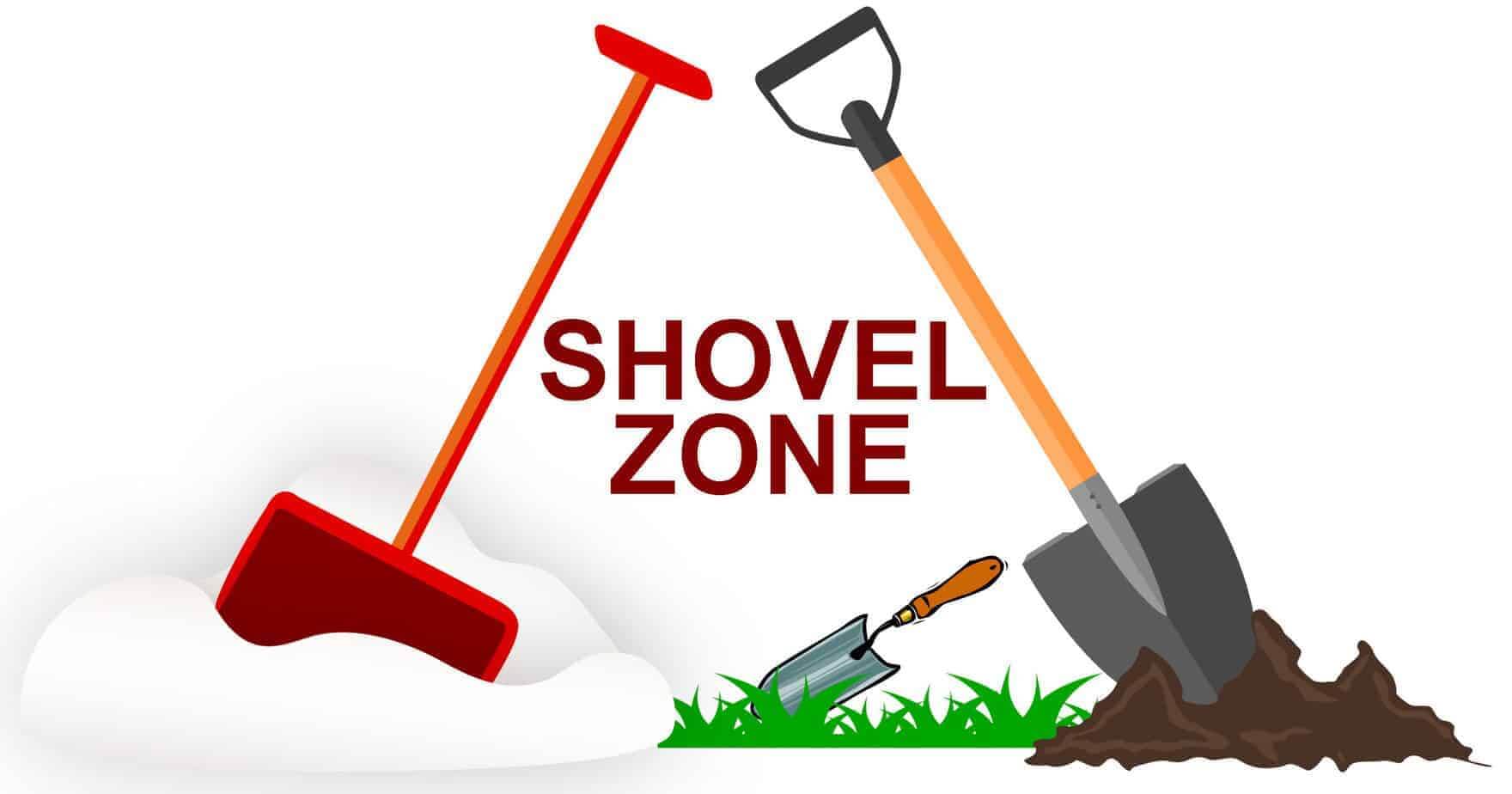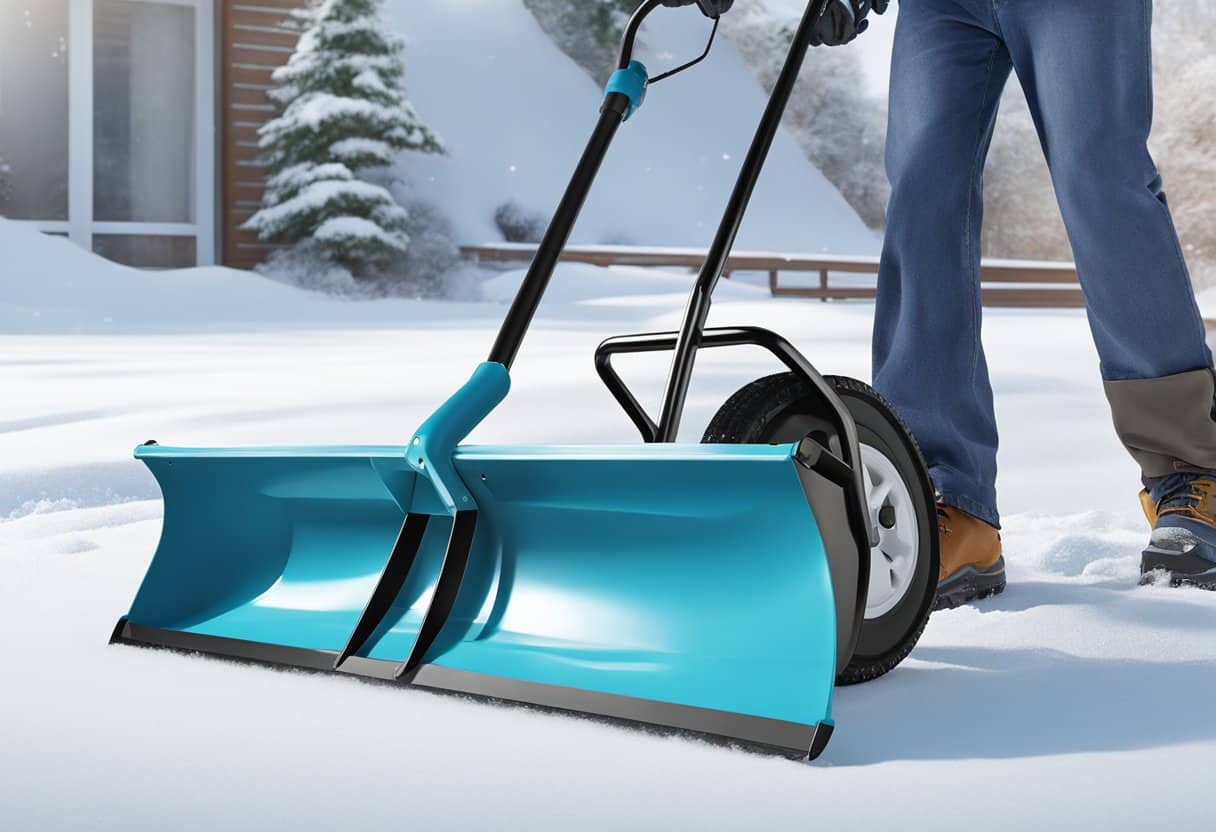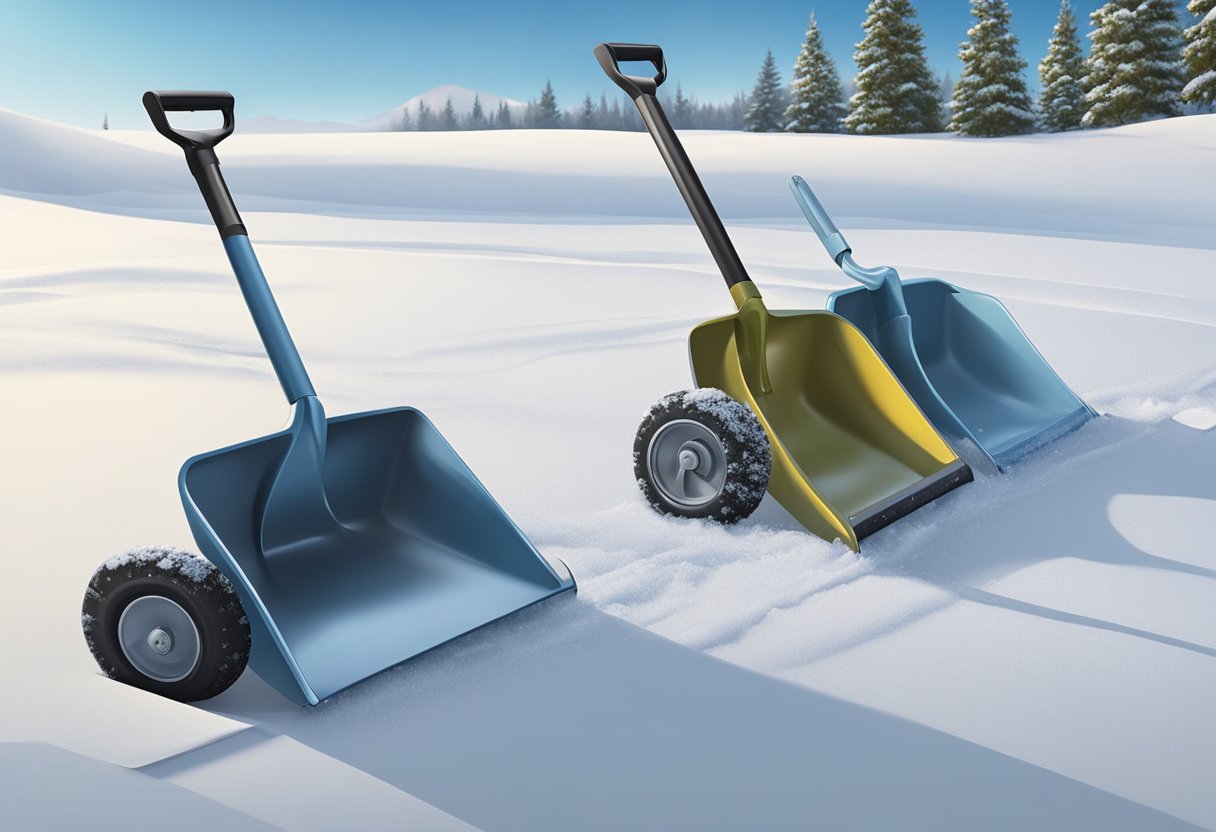As winter weather brings heavy snowfall, clearing driveways and sidewalks becomes a priority for many. Traditional snow shovels require substantial physical effort, leading to strain and discomfort. In recent years, snow shovels with wheels have gained popularity as a way to reduce the effort needed to move snow. These tools leverage the addition of wheels to improve maneuverability, potentially lessening physical fatigue and increasing efficiency.
Table of Contents
Design Of Snow Shovel With Wheels
The design of a snow shovels with wheels plays a critical role in its performance. The right balance between the shovel’s blade size, handle design, and wheel placement can significantly affect how easily the snow can be moved. Equally important are the materials used in construction, which must withstand cold temperatures and repetitive use. Furthermore, the type of snow, whether light and powdery or wet and heavy, can impact the shovel’s effectiveness, and varied designs cater to these conditions.
Designing snow shovels with wheels is an innovative approach to enhance maneuverability when considering snow removal. Adding wheels reduces the physical strain associated with snow clearing by allowing users to push or pull the shovel with less effort than lifting heavy loads. We’ve outlined key aspects of this design below.
Design Elements:
- Ergonomics: Handles are typically adjustable to suit various user heights, reducing back strain.
- Blade Material: Blades are often made of lightweight and durable plastic or metal, designed to handle heavy snow while minimizing user fatigue.
- Wheel Placement: Strategically located to provide balance and ease of movement over different snow conditions.
Advantages:
- Efficiency: The wheeled design improves the shovel’s ability to move snow without lifting, increasing efficiency.
- Ease of Use: Wheels allow smoother motion and require less physical exertion.
Sizes and Models:
- Compact Models: Suitable for light snowfalls and easy storage.
- Heavy-Duty Models: Built to tackle deeper snow and larger areas.
By incorporating wheels into the traditional snow shovel design, users have a way to clear snow that minimizes effort and maximizes productivity. This modification is a testament to the ongoing evolution in ergonomic tool design aimed at improving user experience. Through ongoing innovation and user feedback, the designs have been refined to cater to various snow conditions and user preferences, making the task of snow removal more accessible and less daunting.
Biomechanics Of Snow Shoveling
When we consider the biomechanics of snow shovelling, we’re looking at how our bodies move and handle the physical stress of the activity. Snow shovelling without wheels demands significant effort from various muscle groups. Here is an understanding of the mechanics involved:
Muscle Groups Engaged:
- Upper Body: Utilizes the deltoids, latissimus dorsi, biceps, and triceps.
- Core: Engages the rectus abdominis, obliques, and erector spinae.
- Lower Body: Employs the quadriceps, hamstrings, gluteus maximus, and calves.
Movement Dynamics:
- Lifting: Bending at the hips and knees to scoop the snow.
- Twisting: Rotational movement of the spine to offload the snow.
- Throwing: A combination of arm, back, and leg power to propel the snow.
Using a snow shovel with wheels, aim to reduce the load on our muscles and spine. Wheels facilitate forward movement with less physical exertion. The design of wheeled shovels often includes adjustable handles to maintain a more upright posture, which minimizes bending and reduces lower back strain.
Energy Expenditure:
- Traditional Shoveling: High energy and strength requirement due to lifting and throwing motions.
- Wheeled Shoveling: Lower energy is needed, as wheels assist in moving the snow with less lifting.
By understanding the biomechanics involved, we optimize our approach to snow shovelling, focusing on ergonomics and efficiency. Wheeled shovels offer a design that aligns with our biomechanical considerations, potentially reducing the risk of injury and fatigue.
Comparative Analysis Of Maneuverability
Several vital factors greatly influence maneuverability when we examine snow shovels with wheels. To provide a clear comparison, let’s outline these in a readily accessible format.
- Wheel Size: Shovels with larger wheels can navigate easier over deep snow.
| Wheel Diameter | Ease of Maneuver |
|---|---|
| Small | Less maneuverable on uneven terrain |
| Large | More maneuverable on a variety of surfaces |
- Handle Design: Ergonomic handles reduce the effort needed to pivot and turn.
| Handle Type | Maneuverability Impact |
|---|---|
| Straight | Standard maneuverability |
| Curved | Enhanced leverage and control |
- Shovel Weight: Heavier models require more force to steer, while lighter shovels can be less stable.
| Weight | Maneuverability |
|---|---|
| Light | Easily turned, but may lack stability |
| Heavy | Stable, but harder to maneuver swiftly |
Our assessment considers these factors vital to understanding the maneuverability of snow shovels with wheels. By comparing these characteristics straightforwardly, we can gauge how each design influences the ease with which a user can clear snow. Matching the shovel’s features with the intended use is essential to ensure optimal maneuverability for the user’s environment and snow conditions.
Wheel Design And Traction Control
The design of the wheels is crucial to the maneuverability of a snow shovel with wheels. Aim for wheels large enough to roll over snow and slush easily. Typically, a diameter of at least 6 inches proves most effective.
The wheel material affects both durability and traction. Plastic wheels may not provide enough grip, so we prefer rubberized or air-filled tires that can compress and adapt to the surface for improved traction. This is summarized in the following table:
| Wheel Material | Benefits | Potential Downsides |
|---|---|---|
| Plastic | Lightweight, Cost-effective | Poor traction, Less durable |
| Rubberized | Better traction, Durable | Heavier, May be more expensive |
| Air-filled | Excellent traction, Shock absorption | Requires maintenance, Risks of puncture |
Tread patterns are another aspect to examine. Deep treads and grooves allow for better grip on icy surfaces, reducing the chance of slippage. For enhanced control, opt for:
- Wide wheelbase: The spread of wheels supports stability in heavy snow.
- Adjustable wheels: The ability to change the height and angle accommodates different snow conditions.
For traction control, incorporate features like:
- Metal cleats: These can dig into ice to offer more resistance.
- Locking mechanisms allow the wheels to lock in place for challenging tasks, like chipping away at ice.
In our experience, a combination of rubberized or air-filled tires with a treaded pattern yields a shovel that can navigate effectively through winter’s various challenges.
Ergonomics and User Comfort
When we examine the ergonomics of snow shovels with wheels, consider the design aspects that affect the user’s physical comfort and efficiency. Proper ergonomic design minimizes the strain on the body while maximizing the shovel’s functionality.
Adjustable Handles:
Most wheel-assisted snow shovels come with adjustable handle heights. This allows you to set the handle to a height that prevents you from bending too low, reducing back strain.
- Ideal handle height: varies per individual
- Adjustment mechanism: typically a pin or a twist-and-lock feature
Handle Design:
The shape of the handle also contributes to comfort. An ergonomic grip that suits the natural position of our hands will reduce the potential for blisters and fatigue.
- Standard shapes: D-grip, ergonomic bar
- Materials: often rubberized for grip and insulation
Leverage and Angle:
The angle of the handle about the shovel blade impacts how effectively you leverage your body weight. A well-angled handle allows us to push snow more efficiently without unnecessary bending.
- Optimal angle: varies; look for slightly inclined from the vertical axis
- Benefit: improved force application, reduced effort
Wheel Placement and Size:
Wheels are critical to maneuverability and user comfort. Their placement and size can significantly affect the workload on our bodies. Properly positioned wheels distribute the weight of the snow, making it easier for us to push without lifting.
- Preferred wheel placement: near the back of the blade
- Wheel Diameter: more significant for easier rolling over uneven surfaces
By incorporating these ergonomic features, snow shovels with wheels are designed to create a more user-friendly snow removal experience.
Materials and Construction
Materials are prioritized when designing snow shovels with wheels to ensure durability and ease of manipulation in snowy conditions. The snow shovel with wheels frame is usually constructed from lightweight metals such as aluminum for its strength-to-weight ratio. Occasionally, high-impact plastic can be used for additional weight reduction.
The blades of these shovels are often made from polyethylene or metal. Choose polyethylene for its flexibility, which resists cracking in sub-zero temperatures or select galvanized steel to resist rusting and wear when opting for metal.
| Component | Material Options | Properties |
|---|---|---|
| Frame | Aluminum, Plastic | Lightweight, Durable |
| Blade | Polyethylene, Steel | Flexible, Rust-resistant |
| Wheels | Rubber, Plastic | Traction, Durability |
Wheels are designed for stability and ease of movement across icy surfaces. Rubber wheels with treads offer superior traction, while plastic wheels are lighter and can be more cost-effective. The handles are often ergonomic, with adjustable heights for various user stances.
Utilizing stainless steel bolts and fasteners prevents corrosion and ensures longevity. The connection points are reinforced to withstand the repetitive motion and pressure of shovelling.
Snow Types and Shovel Performance
When examining how snow shovels with wheels perform, consider the type of snow you are dealing with. Different snow conditions can significantly affect shovel maneuverability and efficiency.
Light and Fluffy Snow
- Easier to move
- Less traction needed
- Wheels glide smoothly
Our experience shows that wheel-equipped shovels can move large volumes of light and fluffy snow without much effort. The wheels don’t sink and allow for unhindered movement.
Wet and Heavy Snow
- Requires more force
- Wheels may sink or clog
- Greater physical exertion
Shoveling wet and heavy snow poses more challenges and you will need more force, as the wheels may require a deeper tread to prevent slipping. Wet snow can also accumulate around the wheels, necessitating frequent clearing to maintain performance.
Icy or Compacted Snow
- Challenging for wheels
- May need ice-breaking capabilities
- Shovel design is critical
When tackling icy or compacted snow, wheels can struggle to maintain grip, and the shovel blade needs to be strong enough to chip through the ice. In our experience, adding metal edges on the shovel blade aids in breaking through tough layers.
Maintenance and Durability of Wheeled Snow Shovels
Prioritize the maintenance of your wheeled snow shovels to ensure longevity and optimal performance. These tools can withstand harsh winter conditions and provide reliable service with proper care. Below are maintenance tips and durability characteristics of wheeled snow shovels:
Regular Maintenance
- Check Wheels: Ensure wheels are secure and rotate freely. Lubricate with silicone spray if necessary.
- Fasteners: Tighten loose nuts and bolts regularly to prevent wobbling or parts falling apart.
Seasonal Maintenance
Before Winter:
- Inspect for cracks or wear in the shovel blade and handle.
- Apply a thin coat of wax. Most people use car wax, but you can also use a silicone spray on the blade to prevent snow from sticking.
After Winter:
- Clean the shovel to remove salt and grime.
- Store it upright in a dry place to prevent rusting.
Material Durability
- Blades: Typically made from sturdy polyethylene or metal, resistant to cracking and corrosion.
- Handles: Often constructed from aluminum or steel, providing strength and reducing weight.
Frame and Wheels
- Frame: Opt for powder-coated steel frames to resist rust and extend the shovel’s life.
- Wheels: Choose solid rubber wheels to avoid punctures and maintain traction on snow and ice.
Innovations in Snow Shovel Maneuverability
Recent advancements in snow shovel design have significantly improved maneuverability, making snow removal less strenuous for users. There has been an increase in the integration of wheeled mechanisms, which allow for smoother motion and less physical effort when shovelling snow.
Key Features:
- Wheels: Attached wheels enable more effortless movement over snow and ice.
- Adjustable Handles: Users can modify the handle length for optimal comfort and leverage.
- Ergonomic Design: Curved handles reduce the need to bend, minimizing back strain.
Materials Used:
- Frames: Lightweight aluminum or high-density plastic, which offers durability and ease of handling, is commonly used for frames.
- Blades: Tough, cold-resistant polyethylene ensures that the shovel remains effective in heavy snow while contributing to the overall lightness.
Benefits:
- Reduced Physical Effort: Wheels decrease the need to lift heavy loads of snow, thus lowering the risk of injury.
- Increased Efficiency: Designed for convenience, these shovels push more snow with less effort.
- Versatility: Adjustable elements make the shovels usable by different individuals and for varying snow conditions.
Manufacturers are continually refining these features to enhance the user experience. Our findings suggest that users greatly appreciate these innovations, translating into quicker snow removal times and reducing physical fatigue.
Safety Features for Enhanced Maneuverability
When looking at the design of snow shovels with wheels, prioritize safety features that directly contribute to their maneuverability. These features must be robust to ensure user safety during operation.
Ergonomic Handles: Handles are contoured and padded to reduce user fatigue and offer a secure grip, decreasing the likelihood of slips that can lead to loss of control.
Wheel Treads and Texture:
- Deep Treads: Improve traction in snowy and icy conditions.
- Anti-slip Material: Wheel coating designed to grip surfaces without sliding.
Braking System: This system allows the user to control the shovel’s motion, especially on slopes, and to lock the wheels in place when needed.
| Safety Feature | Functionality |
|---|---|
| Reflective Materials | Enhances visibility in low-light conditions. |
| Weight Distribution | Balanced to prevent toppling and ease turning. |
| Mechanical Locks | Secure moving parts when not in use to prevent accidents. |
Cost Analysis
When assessing the costs of snow shovels with wheels and considering various factors, including the initial purchase price, long-term durability, and potential savings through reduced physical effort. Snow shovels with wheels generally range from $50 to $150, depending on features and build quality. We’ve divided the costs into two categories: initial and maintenance costs.
Initial Costs:
- Basic models: $50 – $75
- Mid-range models: $75 – $100
- High-end models: $100 – $150
These prices reflect the shovel’s material, ergonomic design, and wheel quality. High-end models often provide better weight distribution and more durable materials.
Maintenance Costs:
- Replacement wheels: $10 – $20 per wheel
- Handle repairs: $5 – $15
- Blade replacement: $15 – $30
These components may need replacement over time due to wear and tear.
Here’s a simple breakdown:
| Category | Cost Range |
|---|---|
| Basic Models | $50 – $75 |
| Mid-Range Models | $75 – $100 |
| High-End Models | $100 – $150 |
| Replacement Wheels | $10 – $20 (each) |
| Handle Repairs | $5 – $15 |
| Blade Replacement | $15 – $30 |
Our analysis shows that while the initial investment for a snow shovel with wheels may be higher than a traditional shovel, the long-term benefits, including reduced physical effort and potentially lower health-related expenses, should be considered when making a purchase decision.
Frequently Asked Questions
How effective are wheeled snow shovels in heavy snowfall?
Wheeled snow shovels are highly effective in moderate snowfall but may face wet, heavy snow challenges. Their design allows more effortless movement, but snow’s weight and consistency can affect performance.
Can wheeled snow shovels be easily used by individuals of all strengths?
Wheeled snow shovels are designed to reduce the effort required to clear snow, making them suitable for people of various strength levels. They can be particularly beneficial for those with limited physical strength.
What are the advantages of a curved snow shovel over a straight one?
A curved snow shovel with wheels allows for better snow collection and a more natural ergonomic lifting motion, which reduces back strain and improves leverage.






